Neil M. Robertson
ProSelfLC: Progressive Self Label Correction Towards A Low-Temperature Entropy State
Jun 30, 2022


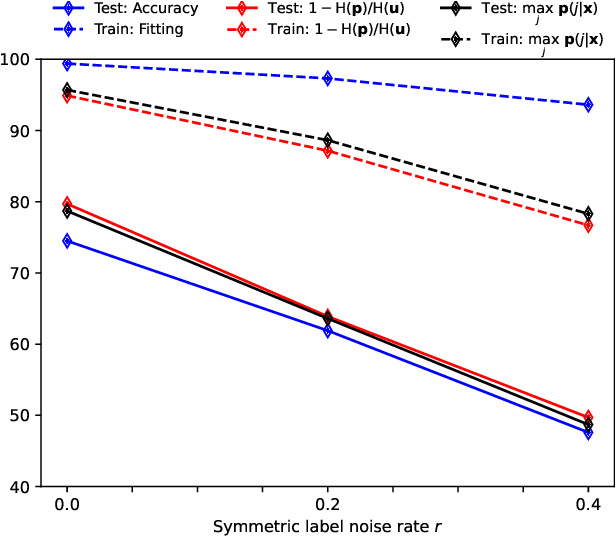
Abstract:To train robust deep neural networks (DNNs), we systematically study several target modification approaches, which include output regularisation, self and non-self label correction (LC). Three key issues are discovered: (1) Self LC is the most appealing as it exploits its own knowledge and requires no extra models. However, how to automatically decide the trust degree of a learner as training goes is not well answered in the literature. (2) Some methods penalise while the others reward low-entropy predictions, prompting us to ask which one is better. (3) Using the standard training setting, a trained network is of low confidence when severe noise exists, making it hard to leverage its high-entropy self knowledge. To resolve the issue (1), taking two well-accepted propositions--deep neural networks learn meaningful patterns before fitting noise and minimum entropy regularisation principle--we propose a novel end-to-end method named ProSelfLC, which is designed according to learning time and entropy. Specifically, given a data point, we progressively increase trust in its predicted label distribution versus its annotated one if a model has been trained for enough time and the prediction is of low entropy (high confidence). For the issue (2), according to ProSelfLC, we empirically prove that it is better to redefine a meaningful low-entropy status and optimise the learner toward it. This serves as a defence of entropy minimisation. To address the issue (3), we decrease the entropy of self knowledge using a low temperature before exploiting it to correct labels, so that the revised labels redefine a low-entropy target state. We demonstrate the effectiveness of ProSelfLC through extensive experiments in both clean and noisy settings, and on both image and protein datasets. Furthermore, our source code is available at https://github.com/XinshaoAmosWang/ProSelfLC-AT.
Not All Knowledge Is Created Equal
Jun 02, 2021
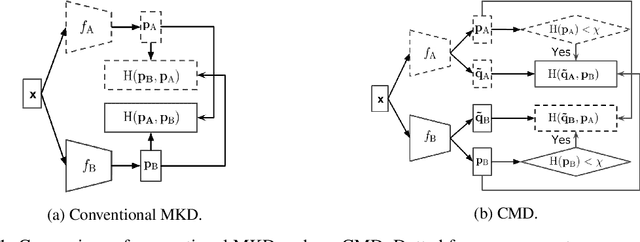

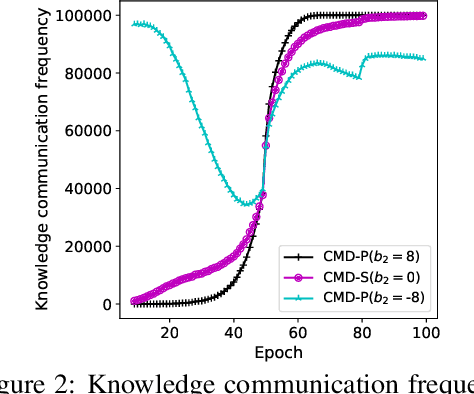
Abstract:Mutual knowledge distillation (MKD) improves a model by distilling knowledge from another model. However, not all knowledge is certain and correct, especially under adverse conditions. For example, label noise usually leads to less reliable models due to the undesired memorisation [1, 2]. Wrong knowledge misleads the learning rather than helps. This problem can be handled by two aspects: (i) improving the reliability of a model where the knowledge is from (i.e., knowledge source's reliability); (ii) selecting reliable knowledge for distillation. In the literature, making a model more reliable is widely studied while selective MKD receives little attention. Therefore, we focus on studying selective MKD and highlight its importance in this work. Concretely, a generic MKD framework, Confident knowledge selection followed by Mutual Distillation (CMD), is designed. The key component of CMD is a generic knowledge selection formulation, making the selection threshold either static (CMD-S) or progressive (CMD-P). Additionally, CMD covers two special cases: zero knowledge and all knowledge, leading to a unified MKD framework. We empirically find CMD-P performs better than CMD-S. The main reason is that a model's knowledge upgrades and becomes confident as the training progresses. Extensive experiments are present to demonstrate the effectiveness of CMD and thoroughly justify the design of CMD. For example, CMD-P obtains new state-of-the-art results in robustness against label noise.
An Image Analogies Approach for Multi-Scale Contour Detection
Jul 21, 2020



Abstract:In this paper we deal with contour detection based on the recent image analogy principle which has been successfully used for super-resolution, texture and curves synthesis and interactive editing. Hand-drawn outlines are initially as benchmarks. Given such a reference image, we present a new method based on this expertise to locate contours of a query image in the same way that it is done for the reference (i.e by analogy). Applying a image analogies for contour detection using hand drawn images as leaning images cannot gives good result for any query image. The contour detection may be improved if we increase the number of learning images such that there will be exist similarity between query image and some reference images. In addition of the hardness of contours drawing task, this will increase considerably the time computation. We investigated in this work, how can we avoid this constraint in order to guaranty that all contour pixels will be located for any query image. Fourteen derived stereo patches, derived from a mathematical study, are the knowledge used in order to locate contours at different scales independently of the light conditions. Comprehensive experiments are conducted on different data sets (BSD 500, Horses of Weizmann). The obtained results show superior performance via precision and recall vs. hand-drawn contours at multiple resolutions to the reported state of the art.
Off-Policy Self-Critical Training for Transformer in Visual Paragraph Generation
Jun 21, 2020



Abstract:Recently, several approaches have been proposed to solve language generation problems. Transformer is currently state-of-the-art seq-to-seq model in language generation. Reinforcement Learning (RL) is useful in solving exposure bias and the optimisation on non-differentiable metrics in seq-to-seq language learning. However, Transformer is hard to combine with RL as the costly computing resource is required for sampling. We tackle this problem by proposing an off-policy RL learning algorithm where a behaviour policy represented by GRUs performs the sampling. We reduce the high variance of importance sampling (IS) by applying the truncated relative importance sampling (TRIS) technique and Kullback-Leibler (KL)-control concept. TRIS is a simple yet effective technique, and there is a theoretical proof that KL-control helps to reduce the variance of IS. We formulate this off-policy RL based on self-critical sequence training. Specifically, we use a Transformer-based captioning model as the target policy and use an image-guided language auto-encoder as the behaviour policy to explore the environment. The proposed algorithm achieves state-of-the-art performance on the visual paragraph generation and improved results on image captioning.
ProSelfLC: Progressive Self Label Correction for Training Robust Deep Neural Networks
Jun 08, 2020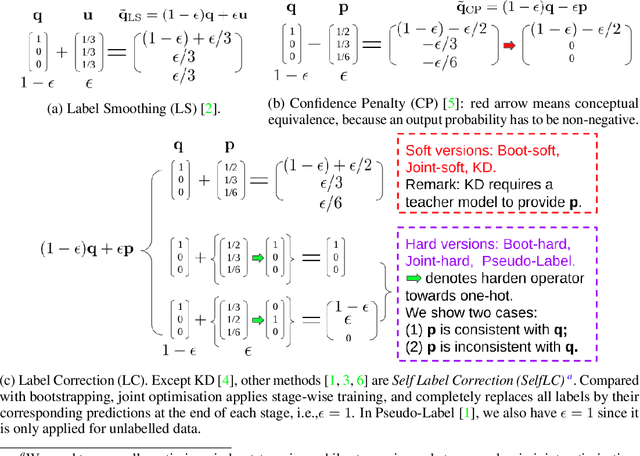


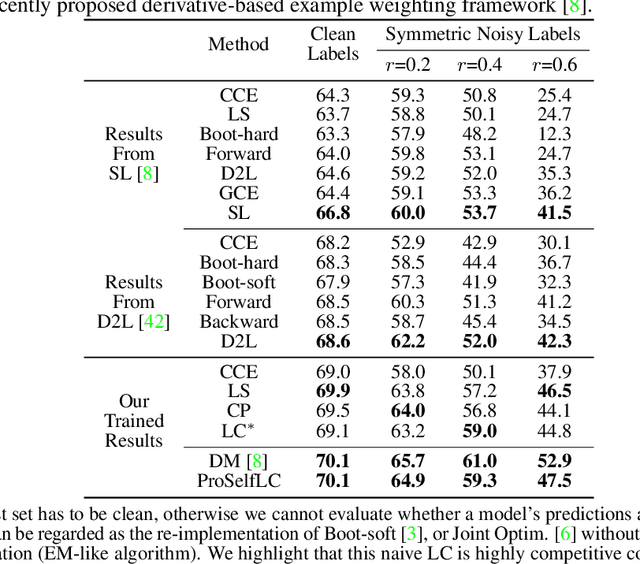
Abstract:We systematically study popular target modification approaches in supervised learning. We show that they can be connected mathematically through entropy and KL divergence. This uncovers that some methods penalise while the others reward low entropy. Additionally, some of them are suboptimal because they do not leverage the knowledge of a model itself; some rely on extra learners or stage-wise training that may require a human intervention thus being difficult to optimise; most importantly, there does not exist an automatic way to decide how much we trust a predicted label distribution, let alone exploiting it. To resolve these issues, taking two well-accepted expertise: deep neural networks learn meaningful patterns before fitting noise [1] and minimum entropy regularisation principle [2], we propose a simple end-to-end method named ProSelfLC, which is endorsed by long learning time and high prediction confidence. Specifically, given a data point, we progressively trust more its predicted label distribution than its annotated one if a model has been trained for a long time and outputs a highly confident prediction (low entropy). By extensive experiments, we show: (1) ProSelfLC can revise an example's one-hot label distribution by adding the perceptual similarity structure information so that its learning target becomes structured and soft; (2) When being applied to noisy labels, it can correct their semantic classes; (3) It outperforms existing methods with the lowest entropy, which indicates it is right for a learner to be confident in correct patterns.
DADA: Differentiable Automatic Data Augmentation
Mar 28, 2020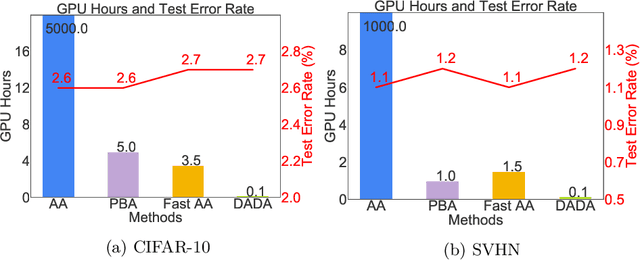

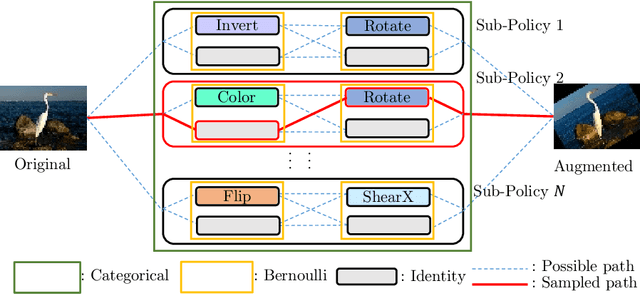

Abstract:Data augmentation (DA) techniques aim to increase data variability, and thus train deep networks with better generalisation. The pioneering AutoAugment automated the search for optimal DA policies with reinforcement learning. However, AutoAugment is extremely computationally expensive, limiting its wide applicability. Followup work such as PBA and Fast AutoAugment improved efficiency, but optimization speed remains a bottleneck. In this paper, we propose Differentiable Automatic Data Augmentation (DADA) which dramatically reduces the cost. DADA relaxes the discrete DA policy selection to a differentiable optimization problem via Gumbel-Softmax. In addition, we introduce an unbiased gradient estimator, RELAX, leading to an efficient and effective one-pass optimization strategy to learn an efficient and accurate DA policy. We conduct extensive experiments on CIFAR-10, CIFAR-100, SVHN, and ImageNet datasets. Furthermore, we demonstrate the value of Auto DA in pre-training for downstream detection problems. Results show our DADA is at least one order of magnitude faster than the state-of-the-art while achieving very comparable accuracy.
ID-aware Quality for Set-based Person Re-identification
Nov 20, 2019



Abstract:Set-based person re-identification (SReID) is a matching problem that aims to verify whether two sets are of the same identity (ID). Existing SReID models typically generate a feature representation per image and aggregate them to represent the set as a single embedding. However, they can easily be perturbed by noises--perceptually/semantically low quality images--which are inevitable due to imperfect tracking/detection systems, or overfit to trivial images. In this work, we present a novel and simple solution to this problem based on ID-aware quality that measures the perceptual and semantic quality of images guided by their ID information. Specifically, we propose an ID-aware Embedding that consists of two key components: (1) Feature learning attention that aims to learn robust image embeddings by focusing on 'medium' hard images. This way it can prevent overfitting to trivial images, and alleviate the influence of outliers. (2) Feature fusion attention is to fuse image embeddings in the set to obtain the set-level embedding. It ignores noisy information and pays more attention to discriminative images to aggregate more discriminative information. Experimental results on four datasets show that our method outperforms state-of-the-art approaches despite the simplicity of our approach.
Improving MAE against CCE under Label Noise
Apr 19, 2019



Abstract:Label noise is inherent in many deep learning tasks when the training set becomes large. A typical approach to tackle noisy labels is using robust loss functions. Categorical cross entropy (CCE) is a successful loss function in many applications. However, CCE is also notorious for fitting samples with corrupted labels easily. In contrast, mean absolute error (MAE) is noise-tolerant theoretically, but it generally works much worse than CCE in practice. In this work, we have three main points. First, to explain why MAE generally performs much worse than CCE, we introduce a new understanding of them fundamentally by exposing their intrinsic sample weighting schemes from the perspective of every sample's gradient magnitude with respect to logit vector. Consequently, we find that MAE's differentiation degree over training examples is too small so that informative ones cannot contribute enough against the non-informative during training. Therefore, MAE generally underfits training data when noise rate is high. Second, based on our finding, we propose an improved MAE (IMAE), which inherits MAE's good noise-robustness. Moreover, the differentiation degree over training data points is controllable so that IMAE addresses the underfitting problem of MAE. Third, the effectiveness of IMAE against CCE and MAE is evaluated empirically with extensive experiments, which focus on image classification under synthetic corrupted labels and video retrieval under real noisy labels.
Ranked List Loss for Deep Metric Learning
Apr 16, 2019



Abstract:The objective of deep metric learning (DML) is to learn embeddings that can capture semantic similarity information among data points. Existing pairwise or tripletwise loss functions used in DML are known to suffer from slow convergence due to a large proportion of trivial pairs or triplets as the model improves. To improve this, rankingmotivated structured losses are proposed recently to incorporate multiple examples and exploit the structured information among them. They converge faster and achieve state-of-the-art performance. In this work, we present two limitations of existing ranking-motivated structured losses and propose a novel ranked list loss to solve both of them. First, given a query, only a fraction of data points is incorporated to build the similarity structure. Consequently, some useful examples are ignored and the structure is less informative. To address this, we propose to build a setbased similarity structure by exploiting all instances in the gallery. The samples are split into a positive set and a negative set. Our objective is to make the query closer to the positive set than to the negative set by a margin. Second, previous methods aim to pull positive pairs as close as possible in the embedding space. As a result, the intraclass data distribution might be dropped. In contrast, we propose to learn a hypersphere for each class in order to preserve the similarity structure inside it. Our extensive experiments show that the proposed method achieves state-of-the-art performance on three widely used benchmarks.
GAN-based Pose-aware Regulation for Video-based Person Re-identification
Mar 27, 2019



Abstract:Video-based person re-identification deals with the inherent difficulty of matching unregulated sequences with different length and with incomplete target pose/viewpoint structure. Common approaches operate either by reducing the problem to the still images case, facing a significant information loss, or by exploiting inter-sequence temporal dependencies as in Siamese Recurrent Neural Networks or in gait analysis. However, in all cases, the inter-sequences pose/viewpoint misalignment is not considered, and the existing spatial approaches are mostly limited to the still images context. To this end, we propose a novel approach that can exploit more effectively the rich video information, by accounting for the role that the changing pose/viewpoint factor plays in the sequences matching process. Specifically, our approach consists of two components. The first one attempts to complement the original pose-incomplete information carried by the sequences with synthetic GAN-generated images, and fuse their feature vectors into a more discriminative viewpoint-insensitive embedding, namely Weighted Fusion (WF). Another one performs an explicit pose-based alignment of sequence pairs to promote coherent feature matching, namely Weighted-Pose Regulation (WPR). Extensive experiments on two large video-based benchmark datasets show that our approach outperforms considerably existing methods.
 Add to Chrome
Add to Chrome Add to Firefox
Add to Firefox Add to Edge
Add to Edge